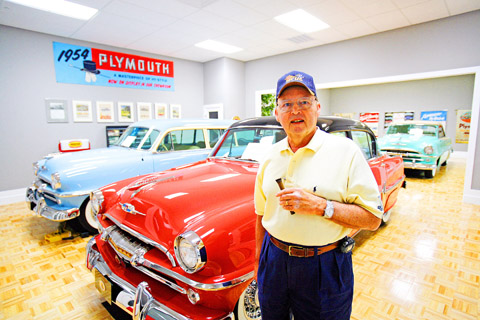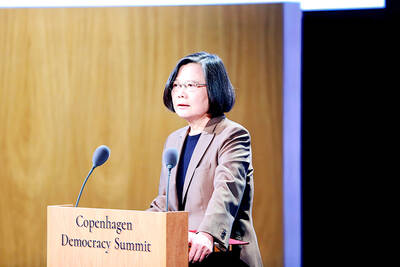Darrell Davis, who retired in 2001 as senior vice president for parts and service at DaimlerChrysler, remembers in explicit detail when and how his passion for Plymouths was ignited.
“When I turned 16 on Monday, Aug. 8, 1955, my mom and I went to the local justice of the peace and filled out the form for my driver’s permit,” he recalled. “We sent it off with special handling, which was available then in Pennsylvania and I had my permit back on Wednesday, Aug. 10.”
Practice at the wheel of the family’s 1954 Plymouth Belvedere followed, but did not last long.

PHOTO: NY TIMES NEWS SERVICE
“I took my driving test on Saturday, Aug. 13, and passed it on the first try,” he said.
He added, with impish delight: “I never rode my bike again.”
Davis said his parents were impressed by how quickly he had become proficient enough to pass the test, given how little tutoring he had received. It seems they did not know how much experience their son already had.
“When I was about 12 or 13 there were usually two cars at home,” he said. “When the family left, I would get the keys and drive around the house and up and down the driveway. All were standard-transmission cars — I was pretty smug about my driving.”
Davis, who went on to spend 36 years working his way up at Chrysler, traces his lifelong love of cars to those practice sessions — and to the times as a toddler that he rode on his grandfather’s lap, steering a 1936 Chevrolet pickup around the family farm near Sharon, Pennsylvania.
Still showing that youthful enthusiasm at age 69, Davis feels little nostalgia for old Chevy pickups. But 1954 Plymouths are another matter. Today he is probably the world’s foremost collector of those models — and an enthusiastic keeper of the flame for the defunct Plymouth brand.
In part of his 836m2 garage near Orlando, Florida, Davis has recreated a fully equipped Plymouth dealership showroom. On display are all four body styles from the then newly expanded 1954 Belvedere line, an upscale alternative to the Plaza and Savoy models. He has collected the sales brochures and display racks, banners, signs, order books and even the sheets of paint samples and upholstery swatches. All of it is meticulously preserved and presented.
“Nobody collects 1954 Plymouths,” he said with a chuckle and a chomp on an unlit half-cigar. “I just collect them because I like them.”
The Plymouth of 1954 was not a success, despite the availability of engineering innovations like power steering, power brakes and the semiautomatic Hy-Drive transmission. (The fully automatic PowerFlite arrived late in the model year.) The chairman of Chrysler at the time, K.T. Keller, had called for designs that were tall and bulky, because, he said, “a gentleman should be able to wear his hat” while driving.
Virgil Exner, a visionary designer whose background included jobs at General Motors and Studebaker, was brought in to enliven the designs. Though Exner’s influence was barely perceptible until the jazzier 1955 models arrived in showrooms, he sprinkled some flash on the 1954 models, part of a so-called Hy-Style treatment. Chrome flourishes, arresting paint schemes, colorful emblems and even wire wheels became available.
But it wasn’t enough; calendar-year sales plunged to 399,900 in 1954, from 662,515 units in 1953.
The seeds of Plymouth’s ultimate demise in 2001, Davis suggests, were sown in 1959 after the bounce-back success of Exner’s 1957 to 1959 finned Forward Look models.
That’s when the Chrysler Corp decided to separate Plymouth and Dodge dealerships, and at the end of 1960, to eliminate DeSoto. Despite some glory years in the late 1960s and early 1970s, Plymouth limped into the 21st century with just a few nameplates.
“I hated to see it go,” he said. “But they probably should have stopped it years before they did.”
Plymouth began in 1928 as a model within the Chrysler line, and Davis owns a blue sedan from that era. He displays it in a separate room alongside the last Plymouth to roll off the assembly line — a silver Neon built on June 28, 2001.
“I don’t need to show it off,” he said, gesturing at his collections. “It’s just for me.”
That doesn’t mean visitors are not welcome. Occasionally local car clubs will stop by for coffee, conversation and the inevitable tour of the showroom or the re-creation across from it of his father’s 1950s-era Esso gas station.
He also has collected die-cast model cars and airplanes, vintage bicycles and even the 1969 Volkswagen Beetle his wife, Jacque, was driving in college when they met.
He estimates that he has owned “a couple hundred cars,” including Ferraris, 1950s Corvettes and full-size Chevys and two Depression-era Chrysler Imperials that won their class at the Pebble Beach Concours d’Elegance.
“I only have 14 cars now, though,” he said, allowing that at any given moment he might expand or contract his collection on a whim.
“I never bought a car as an investment or sold one just to make money,” he said. “I bought it because I liked it; I save what has meaning to me. I don’t need any more out of it than that.”

FALSE DOCUMENTS? Actor William Liao said he was ‘voluntarily cooperating’ with police after a suspect was accused of helping to produce false medical certificates Police yesterday questioned at least six entertainers amid allegations of evasion of compulsory military service, with Lee Chuan (李銓), a member of boy band Choc7 (超克7), and actor Daniel Chen (陳大天) among those summoned. The New Taipei City District Prosecutors’ Office in January launched an investigation into a group that was allegedly helping men dodge compulsory military service using falsified medical documents. Actor Darren Wang (王大陸) has been accused of being one of the group’s clients. As the investigation expanded, investigators at New Taipei City’s Yonghe Precinct said that other entertainers commissioned the group to obtain false documents. The main suspect, a man surnamed

DEMOGRAPHICS: Robotics is the most promising answer to looming labor woes, the long-term care system and national contingency response, an official said Taiwan is to launch a five-year plan to boost the robotics industry in a bid to address labor shortages stemming from a declining and aging population, the Executive Yuan said yesterday. The government approved the initiative, dubbed the Smart Robotics Industry Promotion Plan, via executive order, senior officials told a post-Cabinet meeting news conference in Taipei. Taiwan’s population decline would strain the economy and the nation’s ability to care for vulnerable and elderly people, said Peter Hong (洪樂文), who heads the National Science and Technology Council’s (NSTC) Department of Engineering and Technologies. Projections show that the proportion of Taiwanese 65 or older would

The government is considering polices to increase rental subsidies for people living in social housing who get married and have children, Premier Cho Jung-tai (卓榮泰) said yesterday. During an interview with the Plain Law Movement (法律白話文) podcast, Cho said that housing prices cannot be brought down overnight without affecting banks and mortgages. Therefore, the government is focusing on providing more aid for young people by taking 3 to 5 percent of urban renewal projects and zone expropriations and using that land for social housing, he said. Single people living in social housing who get married and become parents could obtain 50 percent more

Democracies must remain united in the face of a shifting geopolitical landscape, former president Tsai Ing-wen (蔡英文) told the Copenhagen Democracy Summit on Tuesday, while emphasizing the importance of Taiwan’s security to the world. “Taiwan’s security is essential to regional stability and to defending democratic values amid mounting authoritarianism,” Tsai said at the annual forum in the Danish capital. Noting a “new geopolitical landscape” in which global trade and security face “uncertainty and unpredictability,” Tsai said that democracies must remain united and be more committed to building up resilience together in the face of challenges. Resilience “allows us to absorb shocks, adapt under